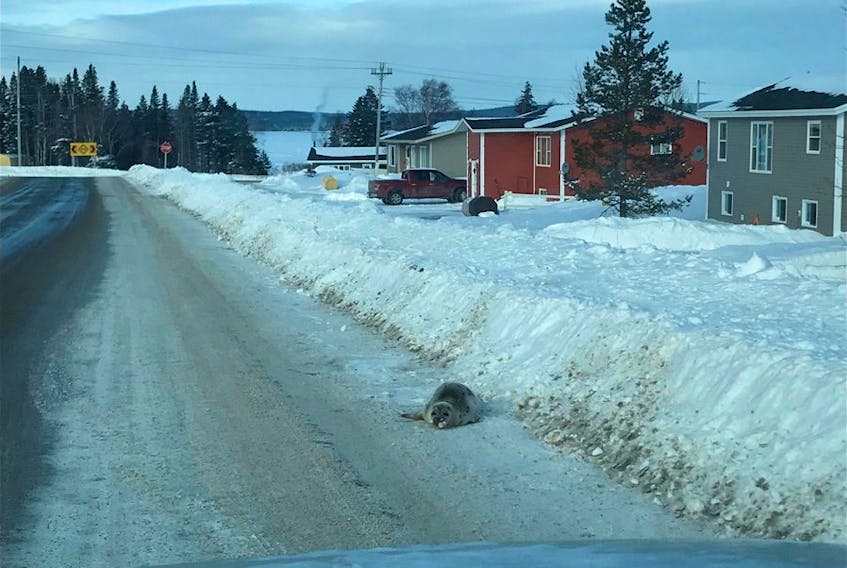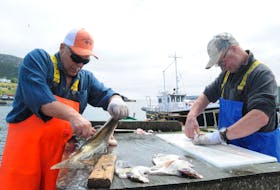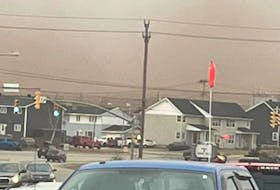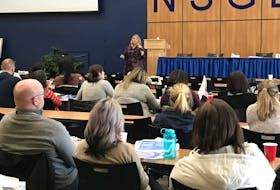UPDATE: Roddickton-Bide Arm council responds to seal stuation
The Roddickton-Bide Arm town council discussed the issue during a council meeting on Jan 8.
It has decided to write a letter to the DFO calling upon them to develop a strategy to take care of and move the seals.
Roddickton-Bide Arm Mayor Sheila Fitzgerald told The Northern Pen during a phone interview the following morning that she doesn’t believe the seals are going to be able to find their way back.
“They’ve been saying let nature take its course, but it’s been almost a week,” she said. “If they could find their way out, they would have found their way already.”
Fitzgerald pointed out that two seals crawling along the road had been hit by vehicles that night.
“They blend in with the road, they’re a light colour and then you got the spots, so when it gets a bit duckish out, it’s hard to see them,” she said.
She credited DFO for their responsiveness in moving the two dead seals but feels more needs to be done to prevent seals from being hit.
Furthermore, Fitzgerald is concerned that there’s not enough food around and the animals are going hungry.
“We’re seeing them more lethargic, they’re not moving as fast,” she said. “It’s really disheartening for people to watch these animals suffer.”
She also points out that it’s hard not to go near the seals when they’re along the sides of roads, in driveways and in business parking lots.
She’s concerned that children may be curious and get too close, even though adults are trying to educate them not to go near the seals.
Earlier story:
RODDICKTON-BIDE ARM, N.L. — The invasion of harp seals in Roddickton-Bide Arm this week is almost reminiscent of an old horror movie.
In Alfred Hitchcock’s 1963 classic "The Birds", a quaint coastal Californian village is attacked without explanation by a swarm of birds.
The critters in Roddickton-Bide Arm are less belligerent, to say the least. And perhaps a reason for their appearance can be discerned.
Yet the sight of seals crawling down the streets of the Great Northern Peninsula town is most unusual and has left some locals concerned.
Brendon Fitzpatrick, the mayor in Conche, a nearby town, drove through Roddickton-Bide Arm recently and took pictures of the seals.
He estimates there were around 35 seals around Eastern Brook and others scattered throughout different parts of town when he was there.
He shared some of the photos on Twitter, including one on the side of the road in Roddickton-Bide Arm.
Fitzpatrick expressed concern that the seals would not find their way back to the ocean, fearing they would head further inland and die.
He was also concerned that locals might unintentionally get too close to the animals which he worried might make the seals quickly turn aggressive.
As of Tuesday afternoon, Jan. 8 it was confirmed by Roddickton-Bide Arm town staff that the seals were still around, having first turned up late last week.

Possible explanation
Garry Stenson, Department of Fisheries and Oceans (DFO) research scientist and head of the Marine Mammal Section, spoke with The Northern Pen and explained how harp seals such as those in Roddickton-Bide Arm can become disoriented when they don’t have access to the ocean.
Firstly, one must understand the migratory patterns of harp seals.
In late fall and early winter, they travel south from the Canadian Arctic and the shores of Greenland to spend their winters off of Newfoundland and Labrador.
During these months, harp seals will haul out on ice off southern Labrador and northeast Newfoundland.
They will feed and get ready for pupping in March, before heading back north in June.
However, Stenson points out that recent ice charts show very little offshore ice in northeastern Newfoundland.
Most of the ice is in bays and inlets such as Roddickton’s and the seals are likely hauling out here, nearer to the coast.
Typically, they will stay near water and move back and forth between the water and the ice; however, sometimes they may enter a situation where they don’t have access to water.
“Sometimes what happens is, either because of onshore winds or freeze-up, they don’t have access to water where they are,” Stenson told The Northern Pen. “And then they get a little disoriented.”
“If there’s no danger to anybody or to the seals we just leave them be and eventually they’ll find their way home." — Garry Stenson, DFO research scientist
Instead of moving towards water, he says, the disorientation means they could head inland.
“So, they don’t have really good searching techniques for finding open water because they’re not normally in those situations,” he said.
Stenson could not say for certain that is what has happened in Roddickton this past week, but it has happened elsewhere and is one potential explanation for the behaviour.
“It’s pretty common,” he said.
Population
According to Stenson, the number of seals does not reflect overpopulation of the animal.
He says it merely reflects a local abundance of seals and nothing more than that.
“It doesn’t reflect population at all,” he said. “What it reflects is local distribution.”
Seal health
Regarding their health, Stenson says harp seals can go weeks without feeding when they’re pupping in March and when they are molting (shedding skin) between April and May.
In other words, seals go through a cycle where they put on weight and lose it.
During this time of year, they are usually feeding and putting on weight.
“A couple of days here and there, it shouldn’t make a big difference,” he said. “But if it becomes prolonged and they can’t get out, then potentially there could be a problem in the long-term.”
Most of the time, DFO will let the situation play out.
“If there’s no danger to anybody or to the seals we just leave them be and eventually they’ll find their way home, or the ice will break up at some point, they’ll go into the water and find their way out,” he said.
If seals are coming onto roadways, where there’s a chance of them being run over, he says the best thing to do is to contact area fisheries officer to have them moved.
“You don’t want to do it yourself or get close to them, you want to stay away, leave them alone,” he advised the public. “If there’s something totally inappropriate about where they are, if they’re in a driveway or in your backyard, then call your local fishery officer.”
Human interaction
DFO says fishery officers are actively monitoring the situation.
The department is advising the public not to interact with the animals.
“A seal is a wild animal that should not be approached or touched,” according to a DFO statement. “Seals are wild animals that can be unpredictable and may become aggressive in order to protect themselves. In rare cases, seals carry infections that can be passed on to humans.”
DFO reminds the public it is illegal to disturb a marine mammal and human interaction can disturb an animal’s normal life process, resulting injury or death of the animal.
The department encourages anyone who witnesses an individual disturbing a marine mammal to contact a local DFO office or CrimeStoppers.
Related story:









